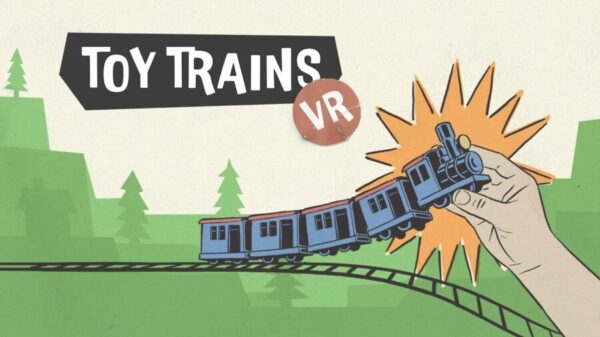
TL;DR for Toy Trains
(played on a Meta Quest 3 128 GB model)
| Pros | Cons |
| + Fun sandbox gameplay | – Too short |
| + Charming aesthetic | – Lackluster English translation |
| + Relaxing score |
Innocent, solitary, peaceful, and playfully imaginative: Toy Trains—from Polish developer Something Random—captures the beauty and freedom of childhood imagination.
If you ever played with actual toy train sets, or perhaps Lego (or maybe if you’re young enough, sandbox games like Minecraft), then you’ll know the feeling I’m talking about. It’s the feeling of solitary fantasy; of knowing it’s just you in here, safe to pour yourself into a make-believe world.
It’s vulnerably taking your first creative steps; telling stories by impressing aspects of yourself upon models and figurines, and expressing yourself through the simple caricatures of a child’s understanding. Just as playing sports buds the athlete, or playing chess buds the strategist, playing in the sandbox buds the storyteller.
So for parents who wish to give their kids a genuinely fun VR sandbox to play in, Toy Trains is a great pick! And for grown-ups who wish to feel that innocent, peaceful nostalgia of childhood creativity—a creativity unbound by deadlines, scarcity, complexity, or cynicism—Toy Trains has something in store for you as well.
GAMEPLAY
This is a short, simple, cozy game in which you connect a central location—like an airport or a community center—to cute little houses on a map occupied by cute little people using—you guessed it—toy trains (as well an infinite catalogue of railway pieces).
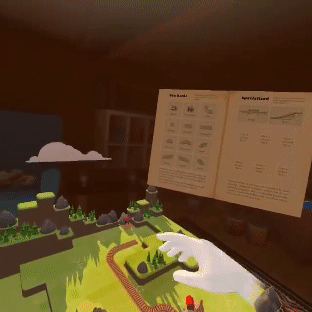
The game has ten levels of increasing complexity. As you progress through the levels, the maps will have more and more obstacles to work around—cliffs, boulders, rivers, and the like—as well as new railway pieces to help you circumvent them.
Each level goes in phases. Once you connect the first couple of houses on the map to the burgeoning central location, that central location will advance a phase in its construction and spawn new houses on the map. Then you’ll have to alter your railway to reach those new houses. This means throwing out old bits of your railway and adding new ones.
Not to fear, however, as there’s no limit to the number of pieces you can use or try, nor is there a time limit to getting there! Toy Trains prefers to keep a casual level of difficulty, assuring you that—with just a bit of effort—you absolutely will succeed.
This casual difficulty can be appealing or aversive, depending on what kind of experience you’re looking for. As someone who personally likes a challenge, I thought the gameplay was a bit piddly at times. But even I enjoyed myself thanks to the game’s charming art style and storytelling.
STORY
The conceit of the story is that you are a child who discovers a toy train set in their grandparents’ basement. You’re staying with your grandparents because your parents are on a trip. They’re professionals of some kind. What kind? You don’t know. You’re just a kid. They send you postcards from their trip. These postcards influence your imagination and mood, altering the theme and tone of each level.
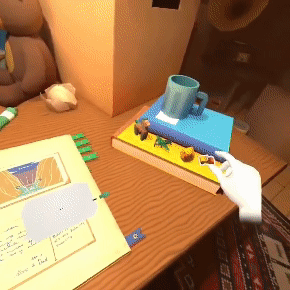
In this way and others, the game puts you into the naive perspective of a child interpreting the world through fresh eyes. For example, to introduce one of the levels, the postcard you receive tells you that your parents are still “putting out fires” on their trip and that once they’re all cleared up, they’ll finally be able to come home.
Every little bit of the game evokes a unified experience.
As adults, we understand “putting out fires” as a euphemism for fixing sudden problems. But of course, the child protagonist doesn’t know that, so then makes believe they’re putting out actual fires with their trains: The central location to be connected for the level is thus a fire station, and the gloomy mood of the level—expressed through the score, the lighting, the NPC dialogue, and the sheer disaster of the blazing wildfires—reflects the protagonist’s disappointment with the news of their parents’ extended absence.
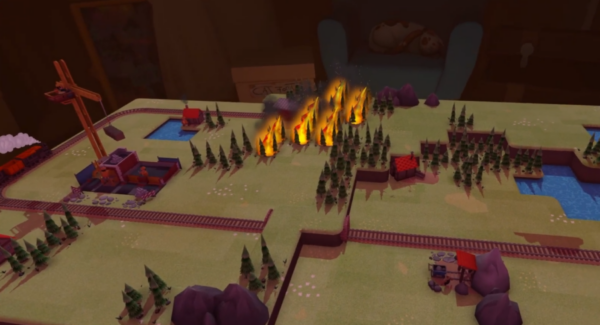
This is Toy Trains’ strongest point: its immersive, unpretentious artistry.
Every little bit of the game evokes a unified experience. There are no menus, only an old-school train catalogue that you leaf through to select a level or piece of railway. The simple, yet emotionally resonant story is told through the postcards you receive and echoed through the dialogue of the imaginary little characters—called “Railies”—whose lives you improve through the construction of your railways. Even the music is played diegetically through a dusty old record player there with you in your grandparents’ basement.
All in all, Toy Trains is an aesthetic achievement.
DESIGN & MORE GAMEPLAY
There’s a great joy found in just leaning in real close and watching a Railey as it dances or floats in a balloon or simply putters about its business, then turning your head and scanning across an entire landscape of busy railroads, cliffsides, and lakes.
In the microscope: The character and map designs are cute and charming. The score is simple, relaxing, and beautiful. The interface is tastefully retro. And the setting is comfortably lived in.
In the macroscope: Completing a level and then just soaking everything in is so satisfying. Watching your little trains doing loops around a fanciful, populated world evokes the dynamic creativity of isometric classics like Roller Coaster Tycoon or Sim City.
Toy Trains is a beautiful experience, but lacks difficulty or depth of gameplay.
The god-like scale and power of the player to shape the toy world of the Railies is artfully juxtaposed with childhood’s lack of agency and the powerlessness kids often correctly feel about the life situations they find themselves in.
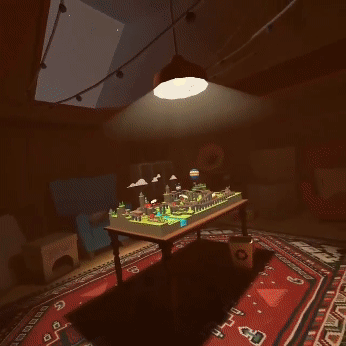
Overall, Toy Trains is a beautiful experience, but lacks difficulty or depth of gameplay. Again, if what you’re looking for is something short, pretty, casual, and relaxing, then that’s not necessarily a problem! But after my roughly three-hour playthrough came to an end, I found myself wanting more.
The game feels like it’s just beginning to open up into a truly sophisticated sandbox experience around level nine, once you’ve unlocked everything in the catalogue. This means that you only get a couple of levels of the freedom of expression that Toy Trains’ full arsenal grants; and only a couple of levels of the challenging terrain that that arsenal is meant to overcome.
Honestly—from a gameplay perspective—it felt like the whole experience was an extended tutorial for a longer game. I can’t help but feel like Toy Trains needs a little bit more content: a random map generator, a free creation mode, or even just another ten levels to play around in with the fully unlocked catalogue!
This need becomes strikingly clear when—if you’re like me—you attempt to go back to play the previous levels with the newfound creative freedom of all your newly unlocked railroad pieces, only to realize that each level can only be played with the pieces that were unlocked at the time of your first playthrough.
There’s no going back to the beginning with the powers you’ve gained by the end.
Overall, the biggest problem I have with Toy Trains is that there isn’t enough of it!
Moreover—while knowing that you can’t lose does contribute to the game’s relaxing vibe—it would be nice if there was an optional harder difficulty for folks like me who appreciate the sense of achievement that comes from overcoming a challenge. This could be done as simply as adding some scarcity, perhaps by adding a limit to the number of railroad pieces you can use, or perhaps by limiting the time you have to complete the level.
Nonetheless, this critique is firmly in the camp of personal taste, so I won’t dock Toy Trains any points for its ease. I will dock it—however—for its lackluster English translation, breaking immersion with its spelling and grammar errors. While these errors are not too frequent, they still have to be mentioned.
VERDICT
Overall, the biggest problem I have with Toy Trains is that there isn’t enough of it! I want more levels, more challenge, and more Railies to gawk at. And that’s a pretty good problem to have.
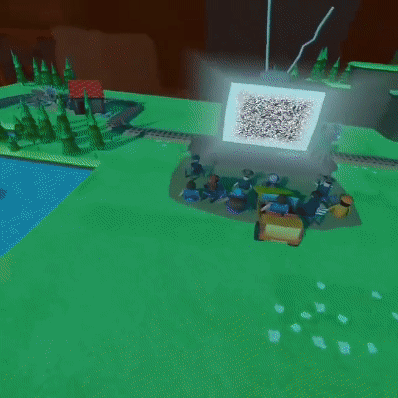
Whether you’re buying Toy Trains for yourself or a child in your life, I recommend checking it out. This game is a beautiful, casual, and relaxing—if too short—nostalgia trip to simpler times.
Toy Trains gets a 7/10.
Scoring & Rubric
Scores are out of 10, where 10 is a masterpiece, 1 is unplayable, and 5 is just average.
Gameplay has a heavier weighting in the overall score.
Gameplay – 7
Immersion – 10
Visuals – 9
Sound – 8
Performance – 8
Replayability – 2
Image credit: Something Random / Toy Trains VR
About the author
Kierkegaard once said that the artist is like one stuck inside Phalaris' brass bull, which burned up its victims and—due to the formation of its apertures—made beautiful music from their anguish.
The critic, he said, is just like the artist except he doesn't have the anguish in his heart nor the music on his lips.
A lifelong gamer based out of Vancouver, Pelé disagrees with Kierkegaard.
